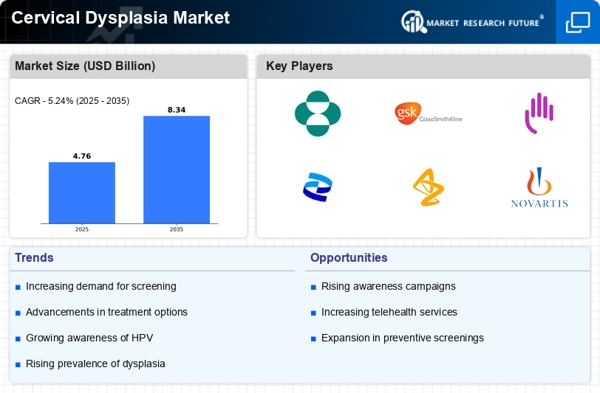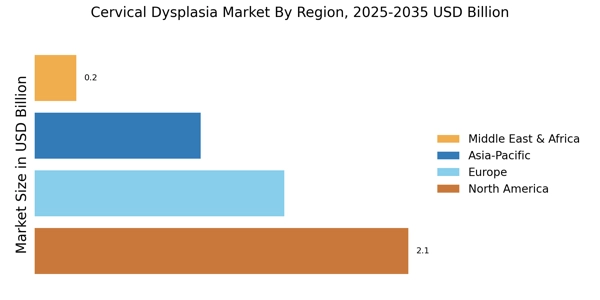The Cervical Dysplasia Market is characterized by a dynamic competitive landscape, driven by increasing awareness of cervical health and advancements in diagnostic and therapeutic technologies. Key players such as Merck & Co. (US), GlaxoSmithKline (GB), and Pfizer Inc. (US) are strategically positioned to leverage their extensive research capabilities and established market presence. Merck & Co. (US) focuses on innovative vaccine development, particularly with its HPV vaccine, which has been pivotal in reducing cervical cancer incidence. GlaxoSmithKline (GB) emphasizes partnerships with healthcare organizations to enhance screening programs, while Pfizer Inc. (US) is investing in digital health solutions to improve patient engagement and treatment adherence. Collectively, these strategies foster a competitive environment that prioritizes innovation and patient-centric approaches.
In terms of business tactics, companies are increasingly localizing manufacturing to enhance supply chain efficiency and reduce costs. The Cervical Dysplasia Market appears moderately fragmented, with several players vying for market share. However, the influence of major companies is substantial, as they often set industry standards and drive technological advancements. This competitive structure allows for a blend of established players and emerging companies, creating a diverse market landscape.
In August 2025, Merck & Co. (US) announced a collaboration with a leading telehealth provider to integrate remote screening services for cervical dysplasia. This strategic move is likely to enhance access to care, particularly in underserved regions, thereby expanding Merck's market reach and reinforcing its commitment to improving patient outcomes. The integration of telehealth solutions aligns with current trends towards digitalization in healthcare, positioning Merck favorably in a rapidly evolving market.
In September 2025, GlaxoSmithKline (GB) launched a new initiative aimed at increasing awareness and education around cervical dysplasia in developing countries. This initiative underscores the company's focus on corporate social responsibility and its intent to address health disparities. By investing in educational programs, GlaxoSmithKline not only enhances its brand reputation but also contributes to a broader public health goal, potentially increasing the demand for its products in these regions.
In October 2025, Pfizer Inc. (US) unveiled a new AI-driven platform designed to streamline the diagnosis and treatment planning for cervical dysplasia. This innovative approach is indicative of the growing trend towards artificial intelligence in healthcare, which aims to improve accuracy and efficiency in clinical decision-making. By adopting such advanced technologies, Pfizer positions itself as a leader in the market, likely attracting healthcare providers seeking cutting-edge solutions.
As of October 2025, the competitive trends in the Cervical Dysplasia Market are increasingly defined by digitalization, sustainability, and the integration of artificial intelligence. Strategic alliances among key players are shaping the landscape, fostering innovation and enhancing service delivery. Looking ahead, competitive differentiation is expected to evolve, with a shift from traditional price-based competition towards a focus on technological advancements, innovative treatment options, and reliable supply chains. This transition may ultimately lead to improved patient outcomes and a more robust market framework.


















Leave a Comment